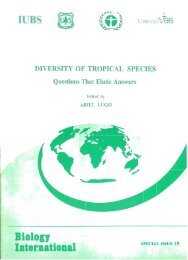SPECIAL ISSUE 34a.pdf - Biology International
SPECIAL ISSUE 34a.pdf - Biology International
SPECIAL ISSUE 34a.pdf - Biology International
Create successful ePaper yourself
Turn your PDF publications into a flip-book with our unique Google optimized e-Paper software.
<strong>Biology</strong> <strong>International</strong>, Speciat Issue No. 34 (1 997)<br />
the zoological Code, precedence mns across those ranks that are considered to<br />
be within each of three rank groups, the species group, comprising species and<br />
subspecies (and also superspecies if used), the genus group, comprising genus<br />
and subgenus, and the family group comprising superfamily, family, subfamily,<br />
tribe and subtribe. Any name published in any of these ranks is considered to<br />
have also been published with the same precedence in each of the other ranks of<br />
the particular rank group. This is termed "CO-ordinate status" and Table 3<br />
illustrates the effect that CO-ordinate status has on the choice of correct narne<br />
under some examples from the botanical and zoological Codes. Although the<br />
Bacteriological Code treats subspecies and species as different ranks and, like<br />
the botanical Code, but unlike the zoological, requires forma1 transfer from one<br />
to the other, it resemble the zoological Code in athibuting equal priority at the<br />
two ranks, namely that of the earlier publication. Melville (1986) discusses the<br />
philosophical basis for the zoological rule on CO-ordinate status.<br />
(iii) Secondary Homonymy<br />
Whereas the general principles of precedence based on first publication of new<br />
scientific names is cornmon across al1 codes, biologists have had much more<br />
difficulty in determining precedence when a taxonornic change is made such<br />
that a taxon, most notably a species, is placed in a different genus from that in<br />
which it was originally described. There are three logical alternatives, and al1<br />
have been adopted at different times. Cunently the zoological Code adopts one<br />
of them and the botanical and bacteriological Codes another.<br />
The first possibility is to regard the first binomen used in the new genus as<br />
having precedence regardless of the correct name in any other genus, including<br />
that in which the species was originally published. This was the basis of the so-<br />
called Kew Rule, widely used in botany in the 19th century, e.g. not only at the<br />
RBG, Kew, but by Asa Gray (Harvard) and Adolf Engler (Berlin) (cf. Stevens,<br />
1991), and most noted as being the basis for some of the taxonomic 1<br />
nomenclatural judgements of accepted narnes in Index kewensis (cf. Nicolson,<br />
1991).<br />
The first botanical Code, the Vienna Rules of 1905, established the procedure<br />
that exists today in botany and bacteriology, namely that the earliest epithet is to<br />
be retained on transfer to another genus, unless by doing so a later homonym<br />
would be created because of the previous use of the same epithet with that<br />
generic name based on a different type.<br />
The third alternative, that used in zoology, involves the concept of secondary<br />
homonymy, in that the earliest epithet is to be used regardless of whether there<br />
is already an independent pre-existing use of that epithet in the genus to which<br />
the species is being transferred. In such a case, the transfer creates a secondary<br />
homonym, whose name must therefore be changed.<br />
Table 4 illustrates the differential effects of the three logical alternative<br />
procedures on the nomenclature of two azaleas, species of the deciduous Section<br />
Pentanthera of the genus Rhododendron. Table 5 gives M er examples of the




